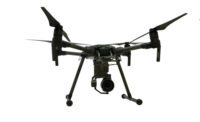 |
| Tap. Shooting water intake wells at a low angle from the riverbank to a sand and gravel bed 100 ft away gives North Dakota water utility a high quality, economical source to boost supply. Pitless adaptor at landside end places valves and connections below the frost line. |
North Dakotas South Central Regional Water District has a new angle for boosting water supplies15°.
Faced with rising demand and a tight budget, the district, serving Burleigh Co., took the advice of consulting engineers Bartlett and West Engineering, Topeka, Kan., and turned to angled drilling from the banks of the Missouri River to tap a sweet spot 30 to 35 ft beneath the riverbed, where sand and gravel naturally filter water seeping down.
 Click here to view diagram
Click here to view diagram
As far as I know its the first under the Missouri River, says Joe Bichler, Bartlett and Wests North Dakota manager.
The district, which serves about 3,500 customers, is overdrawing its contract for water from nearby Bismarck, says Douglas Neibauer, water district manager. His problem was to find 2,400 gallons-per-minute more water.
The districts riverfront water treatment plant was closed in 1996. The Missouri is only 4 to 10 ft deep there, making it too shallow for direct intake, and the original vertical wells were closed due to high mineral content of groundwater.
One plan examined to restart the plant called for two horizontal collector wells with vertical concrete caissons and pumps. But the estimated $3-million cost was too high. So Bartlett and West designed the angled-well approach to tap a zone of groundwater that is conditioned by river water from above. The drilling contract was awarded to Bartlett and West Praut Wells Inc., Waite Park, Minn., which finished proofing the first three wells at the end of December.
Bichler says the shallowest drilling angle possible was expected to be 23°, but the drill achieved 15°. That means we can get a longer length of screen in the zone of targeted water, he says.
Phase I, scheduled for completion in 2007, includes the first three wells yielding a total of 1,730 to 1,900 gallons per minute at a cost of $800,000, plus a $4.8-million upgrade of the old treatment plant. The upgrade will include either micro- or ultrafiltration membranes, plus water softeners. Bartlett and West will solicit bids for redesigning and retrofitting the plant in February.
Phase II, to be complete in 2009, will add two more angle wells and another 1,000 gpm for an additional $800,000, plus another $5-million plant upgrade.
Angle-well intakes are not a panacea, Bichler warns. They do not work well in clay soils and may prove more expensive than horizontal wells when large amounts of water are needed. But angle drilling has its place, he says.
The technique has been used in relatively few water-intake applications to date but is being considered for many, as substratum intakes under open bodies of water are considered less injurious to wildlife and are protected from silt, ice, and low water conditions that can cause problems for other systems, says James Landenberger, BWE senior project engineer. One installation under consideration is for a cooling water intake beneath Long Island Sound for a powerplant at Northport, N.Y. (ENR 4/4/05 p. 17).
Jame Todd, chief of engineering and construction for the Bureau of Reclamation in Bismarck, says BuRec now routinely considers any technology, like angle drilling, that could get us away from fluctuations in lake elevation.


Post a comment to this article
Report Abusive Comment